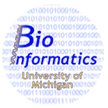| |
|
|
|
March 3-7,
2003
|
Read: Durbin and Eddy,
Chapters 7 & 8
(as much as possible) |
Phylogeny, especially
for protein families. |
Many approaches to phylogeny,
which is, again, a
computationally hard problem. |
March 7-10,
2003 |
Kahn, Qian & Goldstein 2000,
Qian, Goldstein 2002. |
Phylogeny, especially
for protein families, especially one use for making multiple sequence
alignments more accurate. (The preprint links -- right -- are more
directly relevant than the reprint links -- left.) |
Tree
based HMM's for m.s.a.
and classification
of GPCR's
(= G-protein coupled receptors). |
March
12-19
(March 14 canceled),
2003
|
Read: DE, Chap. 7 (parsimony);
Chap. 8 (ML);
HMM: Felsenstein-Churchill 1996,
Mitchison-Durbin, 1995 (not linkable; will be distributed in class). |
Phylogeny: ML; Parsimony;
HMM's in phylogeny.
|
Parsimony most used method for tree estimation; HMM's vary substitution rates across sequence positions.
|
March
21-24,
2003
|
Reference: Brian Ripley, ``Pattern Recognition and Neural Networks", Camb.UP (1995),
Ch. 5: Feedforward Neural Nets.
|
Basics of NN's:
Feedforward nets,
supervised training, backpropagation algorithm;
gradient descent minimization.
|
The ``vanilla" settings for NN's; the complete literature is vast;
few rigorous arguments, very heuristic field.
|
March
26-28,
2003
|
Neural nets in promoter recognition: NNPP;
M. Reese, Comps. & Chem., 26 (1998) 51-56.
|
Time delay NN's;
application to eukaryotic promoter site recognition.
|
Typical use of
NN for pattern recognition, with modification to allow for
flexible location for recognition of the ``same" signal.
|
March
31, 2003
|
Probabilistic
version of promoter recognition: McPromoter.
Ohler et al., 1999.
|
Interpolated
Markov chains;
application to eukaryotic promoter site recognition.
|
Use of
higher order Markov chains for pattern recognition, with modification to allow for
flexible use of available data: weighted use of shorter and
longer context sequences, with (non-probabilistically
enforced) weighting of more commonly occuring context sequences.
|
April
2 - 4,
2003
|
Improvements in McPromoter;
Ohler et al., 2001.
|
Incorporating
biophysical properties of sequences.
|
Ohler's
extension of McPromoter to include DNA physics;
intro to duplex stress and gene promoters (after Benham et al.).
|
April
4 - 14,
2003
|
Term Project
Presentations:
Good luck!
|
Great
variety of topics.
|
Visitors
welcome:
schedule of speakers.
|
April
14 - 17,
2003
|
End of Term:
Sonnhammer
et al., 1998.
Martelli et al. (2002).
|
Trans-membrane
proteins: recognizing helices and beta barrels.
|
Using HMM's
for structural feature recognition.
(Papers taken from the suggested project topics.)
|




